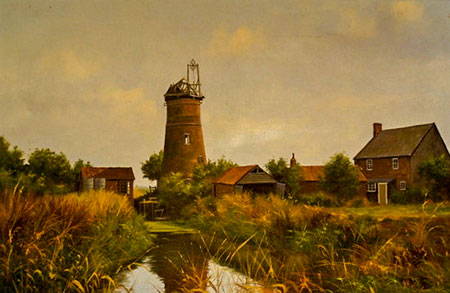 |
Painting by James Wright - 1935 |
Hickling Stubb drainage pump |
 |
Painting by James Wright - 1935 |
Hickling's Stubb Mill was built with a 3 storey brick tower and a 4th story without batter was added later, probably when the mill was updated from common sails to patent sails. The windows on each floor were offset to retain strength and a door was set in the south side. The scoop wheel was against the west side of the tower.
|
On the site with the mill were a cottage and outbuildings. Later on a small modern pumphouse was built beside the mill.
|
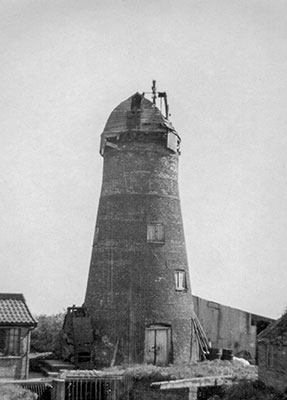 |
1950 |
The Gibbs family once ran the mill and also ran Hickling Eastfield mill and Catfield Swim Coots mill.
|
In a plot on cutting with cottage and small outbuildings on marsh between Hickling Broad and Horsey Mere. Privately owned. Derelict red brick tower (batter changing to cylindrical at top) without cap or sails. Windshaft, brakewheel, fan cradle and striking chain wheel, gear inside; medium size, 4 storey. Scoop wheel. Arthur C. Smith - May 1977 |
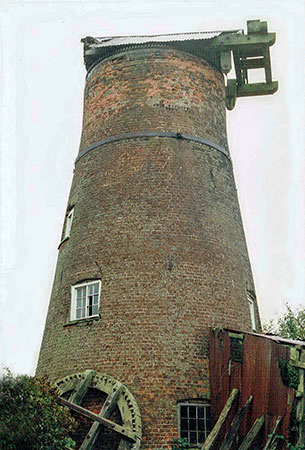 |
1989 |
It was a fitting way to mark the end of a successful scheme to train a new generation of tradesmen in timeless rural skills. But at one of Norfolk's most sensitive conservation sites it was only right that wildlife had the final say when the the new cap was lowered on to Hickling's 200-year-old Stubb Mill. The crane had been readied and the guest list organised for a ceremony in June - until Norfolk Wildlife Trust (NWT) staff spotted a kingfisher nest tucked into the bank of the mill race. NWT reserve manager Matt Bradbury said: "Kingfishers have several broods a year so that's why we have had to wait for the ceremony so long until a gloomy October day." The restoration of the Grade two listed mill has been the flagship project of a four-year Broads Authority scheme to train five millwrights and 10 reed and sedge cutters. Dame Jenny Abramsky, chairman of the Heritage Lottery Fund (HLF), which supported the initiative with a £714,000 grant, was among those watching nervously as a crane slowly lowered the cedar and oak cap at lunchtime yesterday. She said: "This ceremony reminds us that the millwright heritage is a really important heritage not just for this area but the whole country. We do not want these skills to be lost." Dame Jenny added that it was heartening that the 15 original bursars had all found related employment and three of the millwrights had now formed the Millwright Alliance, working on mills across the country. The trainees have tackled the mill restoration, a joint project of the Broads Authority and NWT, under the supervision of Vincent Pargeter from Essex, one of only two millwrights working in the Broads. Their work included repointing and stitching brickwork while abseiling from ropes, removing the temporary roof, building the new cap, treating woodwork and limewashing walls. A windshaft has been installed so should money become available the sails can be put back on. The mill is of architectural importance because it is one of only a handful in Broadland to survive with evidence of living accommodation inside. Its scoop wheel is said to be the largest in the Broads. The ceremony was an emotional occasion for Harry Rudd, 69, who represents the fourth generation who lived in the mill and its outbuildings and looked after it for all of its 200 years. Mr Rudd, who was born and brought up there, remembers the last time the mill was used for pumping in the winter of 1947. He said: "The diesel pump could not cope with the quantity of melting snow and a tractor had to be used to drive the original mill machinery." Brendan Joyce, director of Norfolk Wildlife Trust, said they were proud that the mill - acquired by the Trust in the 1970s - had been returned to some of its former glory. He said his long-term dream was to use the mill again but in a reverse way to its original intention - pumping water on to the land to create more extensive wetlands instead of pumping water off it. The millwrights who have formed the Millwright Alliance - Paul Abel, 22, and Like Harrold, 22, of Attleborough and Stephen Pulfer, 54, of Rockland St Mary, near Loddon - said business had been buoyant in the six months they had been operating. Mr Pulfer, the oldest of the 700 trainees on HLF's £10m scheme to revive heritage skills, said: "The owner of the mill we have just been working on in North Yorkshire said he had been struggling for months to find the right tradesmen." Stephen Pullinger, Norwich Evening News - 7th October 2010 |
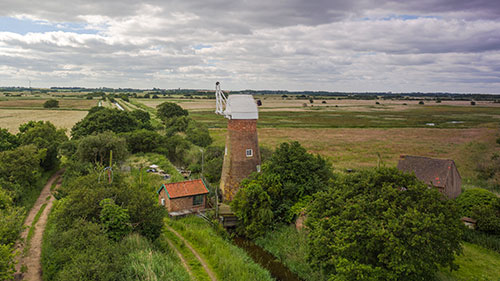 |
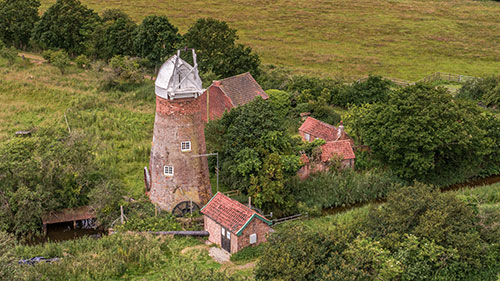 |
1st July 2019 |
|
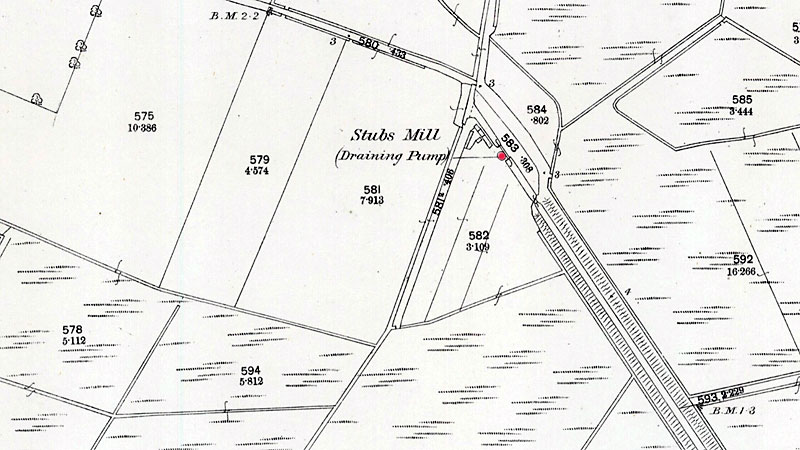 |
|
O. S. Map 1884 Courtesy of NLS map images |
| c.1808: Mill built following the Enclosure Act O.S. map 1836: Drainage pump O.S. map 1884: Stubs Mill (Drainage Pump) 1947: Mill ceased operating 1989: Mill tower with corrugated iron roof; remains of fanstage; brakwheel leaning against tower base 1994: Windshaft, brakewheel, fan cradle, upright shaft, pitwheel and remains of scoopwheel still in situ 2009: Mill given £50,000 grant to provide a new cap and fantail 7th October 2010: New cap fitted to tower July 2019: Mill tower and cap in good condition |
If you have any memories, anecdotes or photos please let us know and we may be able to use them to update the site. By all means telephone 07836 675369 or
|
| Nat Grid Ref TG 43742199 | Copyright © Jonathan Neville 2010 |